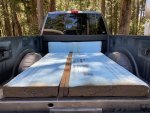Figure how much more height you need. This is kind of tricky as different truck frames exhibit different flexibility. If you have a 3/4 to 1-1/2 inch foam backpacking pad (or whatever, a Yoga mat), slide it into the slot between the cab top and the bottom of the cabover part of your camper to protect your moonroof. With the camper on, have someone else drive it around on undulating dirt roads, over slow dips, getting your axles twisted up with you following to see how much rocking and rolling you get from your setup.
I have no idea how much you get from your Tundra. With as low a payload rating as they have, I'd be surprised if it didn't have movement.
Older Ford frames were notorious for flex. With a lot of negative input from the truck camper community, Ford stiffened their frame by completely boxing them and adding more cross member strength. My new F-350 came with the 5-er prep package (28K pound GCVWR) which by default further strengthens the frame under the bed with more cross members. I have virtually no frame flex with the Northstar aboard and no eyes on ever using a 5-er.
Back about 30 years to the present, because of Fords taller cab in relation to the bed, they have needed more riser height for the camper, any camper to clear the cab.
Do you have a bed mat? A thin one works best with a TC. Less squirm.
So, say you need 2 more inches of altitude to keep your camper from whacking your moonroof.
1. Inquire from a Truck Camper Sales and Service establishment as to what number they use with your specific year truck and specific camper. If they won't tell you, estimate how much more you need and add an inch. It's better to be too high than banging on your cab.
If you have open framing underneath the camper:
1. Drywall screw together a 2x frame with cross members that matches the under framing strength points of your camper. That would be 1-1/2" inches laying flat or 3-3/8 inches on end. Lay this over the 1st, thin (3/8ths inch) bed mat.
You could rip some 2x4's to get in between height, but making a riser sandwich is preferred.
If 1-1/2 inches is a little short, screw a 3/8's to 1/2" weather resistant plywood panel to the framing to increase the height.
Then lay a 2nd rubber bed mat on top of it to keep things from moving around.
Then, apply Camper Guides, screwed to the bed at each side corner of the camper. Will protect the camper from sliding around on god-awful roads, which I'm assuming you be plying. Leave about an inch on each side for ease of loading.
View attachment 681644
2. If your camper has a smooth closed fibreglass bottom, you might consider the 2 inch, 25 pounds per square inch non-compressability foam with a 3/8 inch plywood top and the single rubber bed mat on top of that.
I've done a complete writeup for this on Truck Camper Adventure online magazine.
This is my state of affairs with the riser: 4 inch foam with 2x4 under the framing on he camper. Another 4 inches of foam glued into the camper framing giving the floor an R-40 insulation value.
View attachment 681646View attachment 681645
Your dilemma is all fixable with experimentation to find the just-right sandwich result.
jefe













